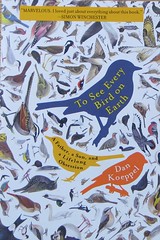 Black-capped chickadees own the feeders in my back yard this time of year, but nuthatches, finches, and siskins stop by, too. Through the kitchen window over the course of the year, I’ve seen four kinds of woodpeckers, sapsuckers and flickers [below], as well as robins, hummingbirds, starlings, and others. The back yard is a diverse aviary. Even so, I’m guessing we’ve only seen about fifty different kinds of birds there. Maybe more. I can differentiate a black-capped chickadee [right] from a chestnut-backed chickadee, for instance, but all those finches might as well be clones. Whether perching at the feeder or splashing in the bath, they look factory-made at this distance.
Black-capped chickadees own the feeders in my back yard this time of year, but nuthatches, finches, and siskins stop by, too. Through the kitchen window over the course of the year, I’ve seen four kinds of woodpeckers, sapsuckers and flickers [below], as well as robins, hummingbirds, starlings, and others. The back yard is a diverse aviary. Even so, I’m guessing we’ve only seen about fifty different kinds of birds there. Maybe more. I can differentiate a black-capped chickadee [right] from a chestnut-backed chickadee, for instance, but all those finches might as well be clones. Whether perching at the feeder or splashing in the bath, they look factory-made at this distance.
 I’m figuring that I’ve consciously seen about 50 birds here, and maybe 150 more on walks, hikes, and various trips. Two hundred. That’s not bad. (It also doesn’t count because I don’t keep a list.) Serious birders have well-documented lists that are 400 to 1000 species long. Then there are the superstar birders (known as Big Listers) that make up the obsession-analysing To See Every Bird on Earth [LibraryThing / WorldCat].
I’m figuring that I’ve consciously seen about 50 birds here, and maybe 150 more on walks, hikes, and various trips. Two hundred. That’s not bad. (It also doesn’t count because I don’t keep a list.) Serious birders have well-documented lists that are 400 to 1000 species long. Then there are the superstar birders (known as Big Listers) that make up the obsession-analysing To See Every Bird on Earth [LibraryThing / WorldCat].
This book was Dan Koeppel’s description, in terms of both admiration and amazement, of his father’s drive to see and list birds. It was kind of a loving way to rhetorically ask “what the heck are you doing with your life, Dad?” I found it much easier to relate to the author, a mountain biking magazine writer, than to his father, a New York doctor who planned most of his entire adult life around where the birds were. His life list — one term among many in this rich subculture of birding — is over 7000 species.
 There are others ahead of him in the lofty perches of birddom (two or three have topped 8000) but the author’s best descriptions lie with his father. Other birders, famous within the community, flit into his text: Roger Tory Peterson, David Allen Sibley, Phoebe Snetsinger (the TOP top lister who was once given six months to live, skipped out on chemo, and did nothing but see birds for the next twenty years!), and Peter Kaestner (a diplomat who is destined to be the new top lister eventually). The book’s center stage is the big listing obsession itself which Koeppel presents with appreciation, awe, and a little head-scratching. It was an enjoyable read.
There are others ahead of him in the lofty perches of birddom (two or three have topped 8000) but the author’s best descriptions lie with his father. Other birders, famous within the community, flit into his text: Roger Tory Peterson, David Allen Sibley, Phoebe Snetsinger (the TOP top lister who was once given six months to live, skipped out on chemo, and did nothing but see birds for the next twenty years!), and Peter Kaestner (a diplomat who is destined to be the new top lister eventually). The book’s center stage is the big listing obsession itself which Koeppel presents with appreciation, awe, and a little head-scratching. It was an enjoyable read.
I read a similar book by a British author a few years back: Birders: Tales of a Tribe by Mark Cocker [LibraryThing / WorldCat]. It focused more on the community of birders (twitchers, as they say in England) than on the Big Listers.
And I won’t sign off without telling you how big a birding list can actually get. Bird classification is ever changing as researchers decide that this forest variety is no different than that mountain variety or that those two species are really three. The total number of bird species is currently somewhere near 10,000. You might have to travel to every tiny island in every country to see all 10,000, but that’s how obsessive the Big Listers become in their quest. (If you want to list the Sangihe Shrike-Thrush, for instance, you’ve got to go to Sangihe Island, north of Sulawesi. Sheesh!)
Want to see the whole list? I did after reading this book. My library doesn’t own it but I interlibrary loaned Birds of the World: A Checklist by James F Clements [LibraryThing / WorldCat]. It’s the Big Lister bible showing the names and native homes of every bird species in the world AND all of their subspecies! No pictures, mind you. It’s just a list. A heavy one. My jaw dropped just paging through it. How can anyone possibly see every bird on Earth?

